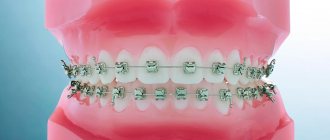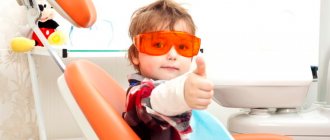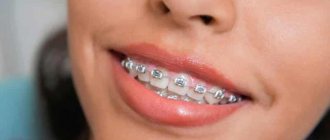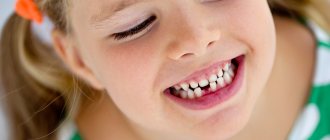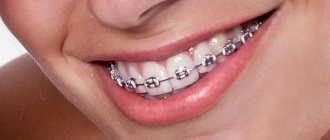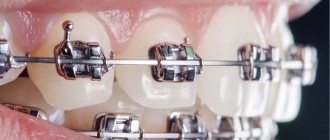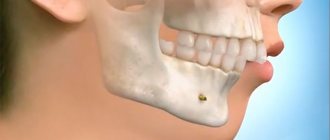Crooked teeth and malocclusion negatively affect not only the health of the teeth and surrounding tissues, but also the child’s self-esteem, self-confidence, and relationships with peers. Therefore, parents turn to an orthodontist with the question: at what age can a child get braces? We will answer in this article.
In this article
- What is malocclusion and why does it occur?
- Why do children get braces?
- Why is it important to correct an abnormal bite?
- At what age do children get braces?
- How are malocclusions treated at an earlier age?
- Until what age are braces placed on adults?
- Types of braces
- Conclusion
What is malocclusion and why does it occur?
A person has two jaws - upper and lower. The closure of the teeth of the two jaws is called a bite. If this closure is even, the bite is considered correct; if the teeth of one row, when closing, overlap the teeth of the second row, they speak of an incorrect bite. Orthodontists treat such dental disorders. Malocclusion often develops in childhood and can be due to various reasons.
- Difficult pregnancy and childbirth.
One of the common causes is birth trauma, which results in pathologies of the neurological system and musculoskeletal system. These disorders lead to improper development of the jaws.
- Mistakes when breastfeeding.
In a baby, the upper jaw is larger than the lower jaw. When a baby nurses, the jaw muscles naturally tighten and alignment occurs. If the baby is not breastfed or eats incorrectly, the formation of a correct bite may be disrupted.
- Poor posture, problems with the musculoskeletal system.
If a child often slouches, not only the spine is deformed, but also the position of the jaw.
- Lack of teeth.
If for some reason a tooth falls out or is removed ahead of schedule, other teeth tend to take up the vacant space, the habit of gnawing hard objects appears, and the tone of the masticatory muscles is impaired.
Also, the cause of malocclusion may be a short frenulum of the tongue, a lack of vitamins and minerals in the diet. The bite is formed incorrectly in those children who often suffer from acute respiratory viral infections and in whom normal nasal breathing is disrupted. They are forced to keep their mouth slightly open, which leads to abnormal bite development.
Contraindications for occlusion adjustment in adults
Unfortunately, not all patients who need to correct jaw anomalies can have braces. There are absolute and temporary contraindications.
Absolute:
- installed implants;
- lack of teeth;
- endocrine diseases;
- mental illness;
- pathology of bone tissue;
- oncology;
- blood diseases.
Temporary:
- acute infections;
- presence of dental diseases;
- enamel damage;
- poor hygiene (stones, plaque);
- bruxism;
- pregnancy.
Why do children get braces?
One of the most popular and effective ways to correct a bite is to install braces. What it is?
A brace system is an orthodontic structure that consists of a metal arch and small plates that are attached to each tooth. The operating principle of braces is based on shape memory. When braces are attached to crooked teeth, they attempt to return to their original position. As a result, it puts pressure on the teeth and moves them in the right direction. It is the doctor’s task to calculate the position of each bracket on the tooth so that they are aligned when displaced.
Children are usually given braces for several years. The design is non-removable, so it is very important to carefully take care of dental and oral hygiene when wearing braces. Bracket systems may differ in materials, structure and other characteristics. By location, they are external (located on the outside of the teeth) and internal. External braces usually cost less and are easy to install. Modern models are made from transparent materials, so they are almost invisible on the teeth.
Lingual, or internal systems, are attached to the inside of the teeth. They are not visible from the outside, so these braces are suitable for a teenager who is embarrassed to wear any structures on his teeth. It is important for parents to know that internal braces are more expensive than external braces. In some cases, minor problems with diction may appear, which usually go away quickly as you get used to it.
Why is it important to correct an abnormal bite?
Some parents do not want to put braces on their children, even if the teeth are severely crooked and do not fit together correctly. They believe that crooked teeth do not affect the child’s health, which means they should not interfere with the natural processes of the body.
Dentists do not share this position. They are convinced that malocclusion needs to be corrected because it leads to a number of problems:
- The child’s speech formation may be disrupted and it becomes incomprehensible.
- Crooked teeth interfere with normal chewing of food, which can lead to gastrointestinal diseases.
- Giving a teenager braces is also important from a psychological point of view. Crooked teeth develop complexes in him, attract negative attention from others, which affects the self-esteem of a boy or girl.
It doesn’t matter at what age you noticed a malocclusion in your child. You should immediately make an appointment with an orthodontist. Even if it is too early to put braces on a child, a specialist may recommend wearing an orthodontic plate or other methods of bite correction. In addition, regular observation by an orthodontist is important at any stage.
At what age do children get braces?
Dentists do not have a common view on this issue. Some orthodontists are confident that from the age of 7-8 years it is already possible to begin bite correction with a brace system. The main thing is that by this age the child’s second molars have fully erupted, the teeth are of sufficient length to attach the bracket, and the enamel has good strength. Other orthodontists categorically do not install dental braces before the age of 13.
So when should you put braces on your child? Most experts agree that it is closer to adolescence. It is important to take into account the individual characteristics of a particular patient, the number of crooked teeth, the degree of malocclusion, the strength of the enamel and many other factors. When a child gets braces too early, there is a risk of damage to tooth enamel, root resorption, and even loss of permanent teeth. Therefore, when asked at what age it is better to install braces, most doctors answer - at 13-14 years old. After installation, you can wear braces until you are 18 years old. This age period is considered the most optimal for bite correction. On the one hand, teeth are pliable and easy to straighten. On the other hand, tooth enamel is strong enough to withstand the heavy load of the orthodontic apparatus.
Installation Features
Braces are installed exclusively by qualified specialists. The reputation of the orthodontist is the main factor that you should pay attention to before visiting the clinic. Correcting irregularities is a long process, you need to be mentally prepared. Teenagers quickly get used to braces systems; the longest stage - installing locks and replacing rubber bands - is carried out by an experienced specialist quickly enough, children do not experience discomfort.
The possibility of complications after installing braces cannot be ruled out as a result of the patient’s neglect of the specialist’s recommendations or failure to comply with hygiene rules. At certain moments, painful sensations may occur that last for several days; the doctor prescribes medications and, if necessary, changes the arch to reduce pressure. The weakening of tooth enamel after the installation of locks is associated with a lack of calcium in the growing body; a specialist prescribes vitamin complexes.
How are malocclusions treated at an earlier age?
If the child has not yet reached adolescence and the doctor does not recommend braces, orthodontic treatment is carried out in other ways.
For example, at 6-10 years of age, children may be prescribed the wearing of removable plates, elastic mouthguards, as well as therapeutic and preventive measures that have a positive effect on the bite. At this time, if necessary, surgical plastic surgery of the frenulum of the tongue is performed, the child is prescribed a set of exercises that normalize the muscles of the cheeks, tongue, and lips. To correct the direction of teeth growth during teething, the orthodontist may recommend a special massage.
When such manipulations are carried out correctly in the oral cavity, optimal conditions are created for proper tooth growth and natural bite correction. In most cases, such procedures serve as a preparatory stage for continued treatment during adolescence, when braces are installed. Early orthodontic treatment can reduce the time spent wearing braces and the amount of medical intervention.
Until what age are braces placed on adults?
If bite correction was not carried out before adulthood, it will be more difficult to correct the violations later. But modern dental technologies make it possible to correct the bite even in adulthood.
The specificity of wearing braces in adults is that the dentition is not so pliable, and it takes more time to change the position of the teeth. Additionally, for adults, braces can be uncomfortable and may require the removal of one or more teeth.
Understanding the difficulties of correcting bites in adults, many parents try to correct the problem in childhood.
5–7 years: treatment can begin
The general rule of orthodontics: the sooner you start treatment, the faster and easier it will be. True, not all orthodontic structures can be used at this age, and much depends on the child himself, his development and the parents’ willingness to constantly monitor the treatment - children are not yet capable of this.
During the period of active replacement of milk teeth with permanent ones, removable plates can be used. They all work on approximately the same principle: they apply force and correct the position of teeth as they grow. Their impact is not very strong, but due to the fact that the child’s jawbone is constantly growing, the roots of the teeth move much easier than in adults. Therefore, such plates have an effect.
Orthodontic plate for children - it is most often used between the ages of 6 and 10–12 years
Various extraoral structures and facial masks are also used. They are usually prescribed if the defect in the jaw structure is congenital. A face mask, for example, will be needed before or after surgery to correct pathology. When used correctly, it can have a significant impact within a few months, correcting the position of the lower jaw and eliminating asymmetry.
Face mask for correcting bite
The point of treatment is to ensure that the permanent teeth erupt immediately in the correct position and do not have to wear braces or aligners later. At an early age, you can influence the very cause of the disorder, helping the body cope with it through growth.
This treatment requires a lot of attention from parents: children are not motivated to wear uncomfortable orthodontic appliances. Therefore, you will have to ensure that the wearing time is observed, and also constantly monitor how the child brushes his teeth.
Types of braces
Modern dentistry offers a huge selection of braces made from different materials:
- Metal ones are suitable for everyone, including teenagers. They are distinguished by their affordable price, durability, and strength. They effectively cope with bite correction, but their aesthetic characteristics leave much to be desired. Therefore, many teenagers do not want to wear metal braces.
- Sapphire ones look more aesthetically pleasing on the teeth and are not as noticeable as metal ones. But they are expensive and cannot cope with all malocclusions.
- Plastic braces have good aesthetic properties, are hardly noticeable on the teeth, but are inferior in strength to metal ones. If the braces break, they will have to be replaced, which delays the orthodontic treatment. Plastic structures may change color due to coloring food and drinks.
- Lingual braces are also suitable for patients of all ages, including children. But for installation you need a sufficient length of teeth. Internal braces are expensive and are not suitable for correcting complex malocclusions. The main advantage is that they are not so noticeable on the teeth.
- Ceramic. Children are rarely given such braces; they are mainly used to correct the bite of adult patients.
Rules of care
The design features of braces systems increase the likelihood of developing inflammatory and carious processes in the oral cavity, so you need to take special care of your teeth during the treatment period.
Be sure to follow the following recommendations:
- brush your teeth after every main meal;
- in the morning and evening you need to use special (V-shaped, mono-beam) toothbrushes and brushes;
- use an irrigator and rinse aids.
Parental supervision, especially in the case of younger children, increases the effectiveness of care.
It is also necessary to monitor the child’s diet: you should not eat solid foods (nuts, crackers, seeds), or sticky foods. It is not recommended to drink drinks with food colorings, and you should avoid sports that pose a risk of injury.
You need to brush your teeth with braces not only with a regular brush, but also with a special brush.

